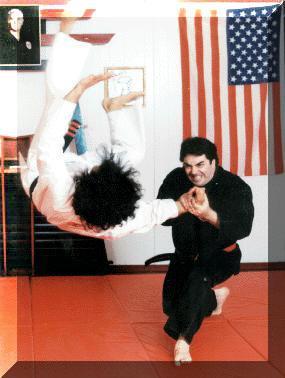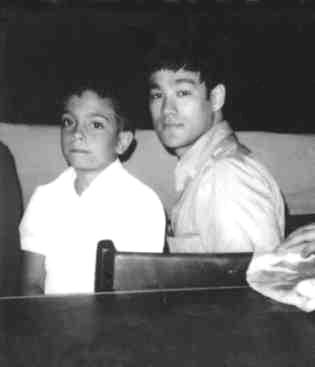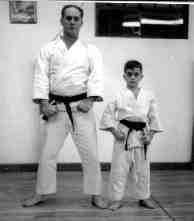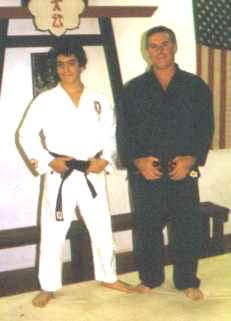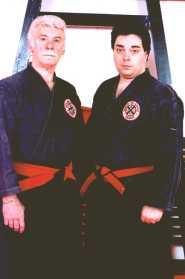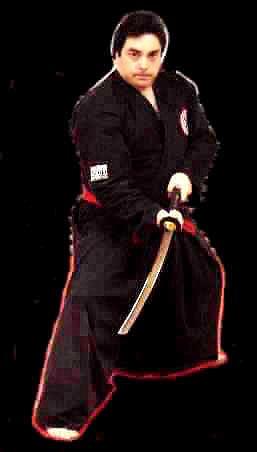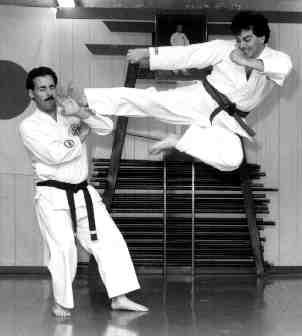|
MARTIALFORCE.COM
PRESENTS
An Interview with Grand Master Pete Siringano OCT 2008 By William Rivera Shihan Edited by Lydia Alicea
P.Siringano: “Bruce Lee was great. He was also humble. I was 9 years old. It was Madison Square Garden at S.Henry Cho’s tournament. The Green Hornet was big and here I was watching Bruce Lee. He was quite unassuming you would never know he was a celebrity.
He knew who everybody was. He did his homework. He knew he was in the minority because it was a New York tournament with all the New York tough guys and the East Coast guys. They were guys in there that if you were to put 10 in a room together would have had more experience than he would in 6 life times, and he knew that. He was really nice to everybody. He did his demo, which included the one inch punch and the two finger push up.
When he was done, he changed and sat ringside. My father was getting ready to do his demo. My father was doing Jiu Jjitsu and brick breaking.
1967
My father had met Bruce at the Black Belt meeting earlier. So he goes to Bruce and asks, ‘Do you mind if my son took a picture with you?’ Bruce says, ‘Just your son, Pete, or else I am going to have a mob scene here.’ We took the picture and I was on cloud nine. Here was Kato from TV! I said ‘Thank-you Mr. Lee,’ and he said ‘Call me Bruce.’ Afterwards we sat and watched my father do his demo. So we are watching my Dad do his Jiu Jitsu, then he does breaking. Two bricks with a downward vertical punch and one with Arnold Morales (one of my fathers Black Belts) holding it, with a shuto.
As we are watching Bruce says ‘Your father is fast, powerful and strong. Are you training too?’ I said ‘Yes,’ and he says ‘You keep it up and one day you will be just like Pop.’ I said ‘You think so?’ and he says ‘I know so, I can see it, now go back to your seat before everybody sees us and wants to come over.’
So what I did not know was that after the tournament we were all going for dinner at Jack Dempsey’s Restaurant. My father knew. So we have a whole back table sectioned off for all the high rankers; Aaron Banks, Henry Cho, etc. Also my Dad and me and Arnold Morales and a couple of the other high ranking Black Belts and Bruce was there with us. So at the table you know, they talk shop. Bruce was very attentive. Listening. He did not have any phony airs about him like; ‘I am superior to your style.’ None of that. Very cordial very friendly man. He was doing the coin trick where he would put the dime in your hand and say ‘I am going to try and grab the dime and you close your hand.’ He let you get it a couple of times than he said ‘Lets try it one more time,’ and than he would do it and you would open your hand and you would have a penny in your hand and he would have the dime. He was a very nice guy. We took that picture and it was a nice thing for him to do for a young fan.
1963
1973
Hello and welcome to Martialforce.com. My name is William Rivera, a Yudansha and student of Eddie Morales Shihan.
Grand Master Pete Siringano is 10th Dan Soke, of Goshindo Kempo Karate and Samurai Jiu Jitsu. He is a former New York City Police Officer, an Actor, Comedian, Musician and renowned Ventriloquist.
This is the first in a two part interview the second part will be on two styles, tied to the past, alive in the present and prepared to deal with the future, Goshindo Kempo Karate and Samurai Jiu Jitsu.
You will get straight answers.
FATHER AND SON 1991
Martialforce: Wilfredo Roldan says you are more technical, and you have more compassion than your father.
P.Siringano: “It depends on what day you catch me on.” (smiling)
“It was a different time, my father Grand Master Siringano Sr., Grand Masters Ruiz, Urban, DePasquale Sr. and others took the Martial Arts to a level where it went from the military to the mainstream. They had certain ways of doing things, and they were a special breed of men. The one thing that they have that you could never take away is what they had here (points to heart,) and what they had here (points to head.) It was also their love for the Martial Arts.
They were no easy ways with those guys, it was Hard-Core. It was kill-or-be-killed type of training. It was not a game. It was not a sport. It was an art, and they instilled that in us. The first generation instilled it in the second generation, and those are lessons that I will never forget, those are life lessons.
As far as technicality, my father had one way of teaching it was the way he learned. He told me, ‘You know the difference between you and me son, and it is not a bad thing. You take the technique and break it down better than I could, you explain things. Sometimes a little too long winded but you explain things the way certain things are and I do not do that, because that is not the way I learned.’
Martialforce: How old were you when you started on the floor?
P.Siringano: “I was 3 years old in a little cut off Gi that he got at Honda. I was in a regular class except for Randori (free style sparring) and Kumite (sparring). Who could Randori with a 3 year old?
Funny story about the heavy bag when I was 3. We lived on Clove Road in Staten Island, N. Y. and the Dojo was right across the street. There was no air conditioning. My father would say ‘If you want air conditioning, pop your Gi and get a breeze.’
I wanted to kick the bag with the rest of the class and my father said ‘Peter you are too small,’ I said, ‘I can do it.’ As all the students got on line to do a right jump kick, I also joined them. I began running brought up my left foot and I go to kick with the right foot completely shy of the bag, went up and landed right on my head Boom!
I got up with a look on my face. My father said, ‘Jiu Jitsu men do not cry. If you want to cry, go to the bathroom,’ and I did, because you do not cry on the Dojo floor.”
Martialforce: How was the training at that young age?
P.Siringano: “Well it was hard because no one really wanted to work out with me for 2 reasons. One they were afraid to hurt me and two they were afraid to hurt Sensei’s son. I mean there was no kids class until years later. I was the only kid for the longest time. And than years later my father decided to have a Saturday class for kids.”
Martialforce: How old were you than?
P.Siringano: “About 7, but he never taught the kids class he had one of the other Black Belts teach the class, because my father loved kids but he hated parents.”
Martialforce: What were the classes like growing up?
P.Siringano: “It was hard-core. There was no wiping sweat of the face, there was no scratching your ass or looking over there, there was looking straight ahead, standing at attention in hachi-dachi (ready stance.) You do not complain, you do not feel pain, and you work hard. It was 15 to 20 minutes calisthenics, drilling punches, kicks technique, and you worked, big guy, little guy, female all the same class.”
1988
Martialforce: Who sought the school?
P.Siringano: “Many different types. Past military types, women for self defense, guys who never learned how to fight back, and the occasional psycho. The last type never made it past night one.”
Martialforce: What was your Shodan grading like?
P.Siringano: “God. I will be on my death bed and I will still remember that night. I was 15 years old I was a Brown belt (I-kyu) I was working out 4 nights a week. Monday and Thursday was Jiu Jitsu, Tuesday and Wednesday was Karate.
I remember we had started the class just like any other class we had 25 to 30 guys on the mat, back in the day we had an elevated mat. It was Jujitsu night in October and he was riding me all night. I am thinking ‘What did I do? I did my homework, I did all my pushups.’ He said my techniques were all wrong.
‘All right everybody Yame, sit. Alan, Peter get up here.’ Alan King was one of my father’s black belts. We bow in we spar and than he starts with every black belt and makes me fight everybody down to the newest white belt. By the time I got to the new guy he is kicking my ass I cannot keep my arms up anymore. ‘Yame get over here, bow in.’ Now I am fighting him.
I am thinking ‘What the hell did I do?’ I can hardly breathe anymore. Now he is sweeping me wham, bam, he is wiping the floor with me. Throwing me into the wall, knocking me off the mat into the benches.
Finally I am choking back tears at this point because I am like ‘Ok what ever I did in my past life, why am I paying for it tonight? Can we not space it out over the next couple of years?’ Finally it ends. I look around wondering why is everybody up, and he starts with the speech. ‘When you are on that mat and you are sparring you have to be like this and that, and my own son tonight…. YOU get over here!’ Now I am thinking ‘What is he going to do, demote me? Crack me in front of the whole Dojo?’
He pops this Shodan obi out of his sleeve, ‘Put this obi on.’ So now I am fumbling trying to get the other one off and trying to put the new one on. ‘What is the matter you forgot how to tie an obi?’ ‘No Sensei.’ ‘That knot isn’t right.’ ‘Yes Sensei.’ He gives me a handshake, congratulates me and I get back in line.”
Martialforce: The Black Belt represented both styles?
P.Siringano: “Yes.”
Martialforce: If you were 10 years old and could do what a Black Belt could do, age not withstanding would you have been promoted to Black Belt?
P.Siringano: “No, because I could not do what a Black Belt can do. If I paired off against a guy like you, you would bury me. To my father there was no difference in a Black Belt. Man, woman it did not matter. There was no special Black Belt. You were a Black Belt.”
Martialforce: Have you changed the way you learned the Art.
P.Siringano: “I have kept the tradition. That, I will never get rid of. I turn away more people than I take in. I believe as did my father that this is a Martial Art not a ‘Material’ Art.”
Martialforce: With all the Jiu Jitsu what is Jiu Jitsu?
P.Siringano: “Jiu Jitsu is literally translated soft art, or soft style. They say that all the Japanese arts sprung from the original Jiu Jitsu style. Karate, Judo, Aikido. Jiu Jitsu already had all those techniques in it. It is like a “Giambotta” as we say in Italian. You take everything and you put it in the pot. Pork, sausage, beef, rice, lamb if you take all those components out you have individual dinners. You got a pork dinner, a rice dinner you got a beef dinner, you got a lamb dinner but when you put them all together that is Jujitsu, Everything.”
Martialforce: You break (boards & bricks) and hit the makiwara (striking post) why are your knuckles not broken up and callused?
P.Siringano: “Because I hit it right.”
Martialforce: What do you mean by hit it right?
P.Siringano: “I do not graze my knuckles. I do not rip my knuckles or twist my knuckles. The idea of hitting a makiwara is not to have ugly hands but to have hard hands. I tell people who have all calluses and ugly looking knuckles you are hitting it wrong.
Makiwara like anything else is technique and your hands should not look like you can strike a match on it. My father never had ugly hands. He used to break bricks. He used to bleed he would rip the skin off. I have seen him break 2 bricks on top of each other no spacer with a shuto (knife hand.) His favorite one was downward vertical punch breaking a brick. His hands were not ugly but they were hard they were impervious to pain.”
Martialforce: What were Grand Master Siringano Sr.’s thoughts on Makiwara training?
P.Siringano: “I have seen my father snap a makiwara in half and get mad because he would have to build another one. My father would say ‘You could hit that makiwara all you want but if you have no technique those knuckles are not going to do you any good if you cannot hit the man. You can punch it all day long but if you are punching at a live object and the guy parries that punch with those big knuckles and takes you down what good is that? You are going to be an unconscious guy with big ugly knuckles lying on the ground.’ It is about technique.”
Martialforce: What is Ki?
P.Siringano: “People try to define Ki and they try to teach Ki. Teaching Ki is like teaching people how to breathe. It is a life style it is a life force. Ki is what Michael Phelps had when he won that race. Ki is what every gymnast has when they stick a landing. Ki is what a priest has when he comforts somebody who is sick. Ki is something that everybody has, but they do not know how to channel it or control it or focus it in a positive direction for doing good.
When a mother is giving birth to a child there is incredible pain that goes with natural child birth but she puts that pain away. Because she knows she is bringing a life into this world so she does not focus on the pain she focuses on this little person that she has been carrying for nine months and about to come into this world, and be a living breathing person. That is Ki.
Relative to Martial Arts, Ki is what allows you to break boards, to break bricks to focus your energy to be able to nail a Kata meta-perfect. To get up in front of a class and teach with leadership, to be respected by people to carry yourself in that positive Martial Way. It is so much.”
Martialforce: How do you teach it, and how were you taught it?
P.Siringano: “My father taught it to me in the Dojo with various exercises. The resistance exercises and intense channeling of energy into a smaller area whether it be a shuto (knife hand) or a seiken (forefist) or a nukite (spear hand). And just the way he would demonstrate techniques. Watching his feet. Watching the position of his feet. His body. His tai-sabaki (body shifting) and seeing him when he was in the circle with him in the middle of the circle and he would say ‘Come at me one, two at a time. Just come at me.’ He did not even have to think about what he was going to do. Nothing rehearsed.”
Martialforce: What are your thoughts on grappling?
P.Siringano: “If you find yourself on the ground you better know what you are doing. What needs to be understood is, grappling is not the beginning or end to it all, it is just one aspect of the Martial Arts.”
Martialforce: Growing up and being taught by Grandmaster Siringano, did you hold an expectation that someday you would inherit, and take over the style?
P.Siringano: “When I was young, and still a kyu rank, I really never thought about it. I couldn't see that far down the road to a time when my Father and Sensei would be gone. I thought he'd be around forever, as most sons do. He had senior Black Belts, but I think that HE always hoped I would take over one day. When I got older, I began to realize that he was grooming me to one day wear his Obi.”
Martialforce: Did you feel there were higher expectations placed on you by your father or yourself?
P.Siringano: “Both. I couldn't show hurt, pain or fatigue. I had to set an example. So when I got hit, and it hurt, I sucked it up. I had to make him proud of me. I think he knew that as well, but he never let on that he was proud of me, not in the early years, anyway.”
Martialforce: Did your father hold you to a different standard as you trained alongside your fellow martial artists?
P.Siringano: “Absolutely my Dad held me to a higher standard than his other Black Belts. He was hard on me in and out of the Dojo. Other people went home at the end of the night, and that was that. I lived Jiu Jitsu and Karate 24/7. At times, he wasn't the easiest guy to live with. Very old school, but I don't regret one minute of my strict upbringing. It has helped me be strong enough to deal with many of life's obstacles. And I thank Dad for that.”
Martialforce: When were you given your 9th dans?
P.Siringano: “A month to the day my father passed away he called me to the house and gave me 9th Dan to both styles. He said ‘When the time comes you are the only one in the world with these certificates.’
Martialforce: You’re the inheritor of the style. What was the problem with people not accepting this?
P.Siringano: “It does not matter if I have the most knowledge. You have been in business. If you work for a company, a small company, there is the father and than there is the son and than there is the CEO underneath the son, and than there is everybody else. 9 times out of 10 when the father passes away the company goes to the son. Well, these knuckleheads did not understand that.
Dad never asked for anything in return except loyalty and respect and that was gone. Some thought as soon as he died they would make themselves a 10th Dan, breaking off from the system saying to others ‘I am breaking away from the system. Would you sign my certificate?”
Martialforce: Did your father teach you everything there was in the systems?
P.Siringano: “My father taught me everything I know, not everything he knows. I am sure he took stuff with him. But he taught me more than he taught everybody else.”
Martialforce: Where do you see yourself taking the system?
P.Siringano: “I do not want to take it anywhere I just want to keep it alive. And I can not take it anyplace because he has already brought it from where it was to where it should be.
I have done the videos, I have done the websites. So that has taken it to the 21st century. But as far as the techniques, as Arnold Morales one of my fathers 5th Dans (a Venezuelan Gentleman whom my father trusted with his life) says ‘A punch in the nose is a punch in the nose! I do not care what you call it, but that is what it is.’ So the techniques are the techniques. I cannot improve on that, because if it is not broke you do not fix it. My father was the one who took it from military almost obscurity bringing it to a closed group type of private thing to opening it up to the public.”
Martialforce: What do you say about tradition? What you learned then you can not apply now?
P.Siringano: “I seem to remember an old man going up into a mountain and getting 10 Commandments. That was over 4000 years ago they’re still good today. If that is not tradition, I do not know what is. The problem with the martial arts today is everybody is trying to re-invent something. You cannot re-invent the wheel. You can not re-invent the elements, they are what they are. The same thing with Jiu Jitsu. Everybody wants to put their spin on it and call it their thing. Over the years the art has been refined a little more but the way the techniques are right now there is nothing really I can add to it. I can perpetuate it keep it going which is my goal.”
Martialforce: Thank-you Grand Master Siringano and thanks to your family for
allowing us the opportunity to conduct this interview into the late hours of the
night. One Life – One Art
|
